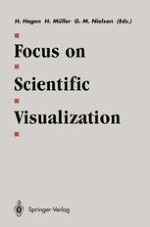1993 | OriginalPaper | Buchkapitel
Volume Synthesis Principles
verfasst von : Arie E. Kaufman
Erschienen in: Focus on Scientific Visualization
Verlag: Springer Berlin Heidelberg
Enthalten in: Professional Book Archive
Aktivieren Sie unsere intelligente Suche, um passende Fachinhalte oder Patente zu finden.
Wählen Sie Textabschnitte aus um mit Künstlicher Intelligenz passenden Patente zu finden. powered by
Markieren Sie Textabschnitte, um KI-gestützt weitere passende Inhalte zu finden. powered by
There is a recent increase in the use of discrete voxel representation for a variety of geometry-based applications. These include CAD, simulation, and scientific visualization, as well as those that intermix geometric objects with 3D sampled or computed datasets. In these applications the inherently continuous 3D geometric scene is sampled employing voxelization (3D scan-conversion) algorithms, which generate a 3D raster of voxels. The voxelized objects have to conform to some 3D discrete topological requirements such as connectivity and absence of tunnels. During the voxelization process, also termed the volume synthesis process, each voxel is assigned precomputed numeric values that represent some measurable view-independent properties of a tiny cube of the real or simulated object. These values are then readily accessible for speeding up the rendering or the discrete ray tracing process. The voxelization algorithms are the 3D counterparts of the 2D scan-conversion algorithms, and the 3D raster generated by them is the 3D counterpart of the conventional 2D raster.
